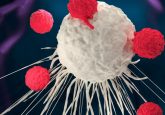Urine-based test detects head and neck cancer

Researchers have developed a urine-based test to detect head and neck cancer, opening the door to more accessible screening.
Early detection of cancer is critical as it can result in better outcomes for patients. However, while some cancers have reliable screening methods, this is not the case for all cancers, such as head and neck cancer. Now, researchers from the University of Michigan Health Rogel Cancer Center (MI, USA) have developed a urine-based test that successfully detects tumor DNA fragments in individuals with head and neck cancer, offering a non-invasive alternative to blood-based tests. They believe that similar tests could be developed for other cancers.
Tumor cells release DNA fragments, known as cell-free tumor DNA (ctDNA), which can be detected in biofluids such as blood, plasma and urine. Urine-based tests offer promise as they are noninvasive and overcome limitations associated with volume and frequency of specimen collection. The samples can also be collected at home, making it easier to reach underserved populations and enabling more efficient cancer screening on a population-wide scale.
However, urine-based tests for cancer have traditionally only been utilized for cancers linked to the urinary tract, such as bladder and prostate cancer. There have also been mixed reports on the efficiency of detection of transrenal ctDNA (TR-ctDNA), the ctDNA that passes from the bloodstream into urine through the kidneys, compared to ctDNA detection in blood.
 Non-invasive diagnosis of Alzheimer’s disease from saliva samples
Non-invasive diagnosis of Alzheimer’s disease from saliva samples
A non-invasive, handheld Alzheimer’s diagnostic test could be on the horizon.
To investigate this, the researchers conducted whole genome sequencing and found that TR-ctDNA across multiple cancer types is predominantly ultrashort, often with fewer than 50 base pairs. This small size means that these fragments are likely to be missed by conventional urine or blood-based biopsy assays since they are designed to detect longer DNA fragments.
The team then developed an ultrashort droplet digital PCR assay that successfully detects TR-ctDNA originating from HPV-associated oropharyngeal squamous cell carcinoma. Although the test is still in its early stages, it was distributed to individuals in Ann Arbor (MI, USA) who have received treatment for the disease as posttreatment surveillance to gather data on the efficacy of the test. Participants collected a urine sample and sent it back to the lab, where the team used the test to detect the presence or absence of head and neck cancer.
“One of the most remarkable outcomes of this study is that the test that has been developed has detected cancer recurrences far earlier than would typically happen based on clinical imaging. As such, these promising results have given us the confidence to broaden the scope of the study, seeking to expanding distribution even further,” said J. Chad Brenner, co-senior author of the study.
While the initial study focused on head and neck cancer, the team also analyzed urine samples of people with other cancers, such as breast and acute myeloid leukemia, and found that ultrashort TR-ctDNA was present in their urine. This suggests that urine-based tests could be applied in the diagnosis of a broad range of cancers.
“Many people are not aware that urine carries information about many different cancer types, although it is made in the kidneys. Our findings about the difference in ctDNA fragment sizes and the test we developed for HPV-positive head and neck cancer detection provide crucial information on how urine-based diagnostic assays can be developed for different cancers,” commented co-first author Chandan Bhambhani. “Further, these types of tests are likely to have a much higher compliance in patients requiring follow-up testing post treatment, due to the convenience of self-collection of samples, when compared to blood-based assays.”





